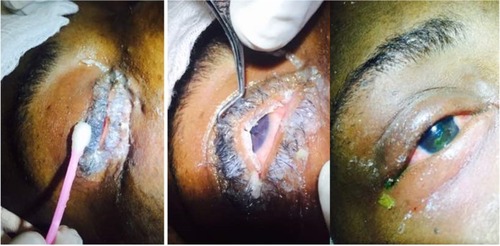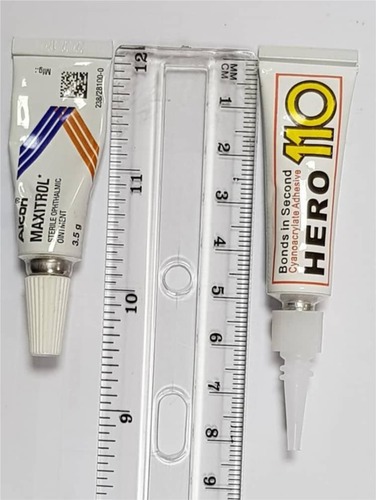Abstract
Background
Ocular superglue injury is uncommon all over the world.
Aim
To report a case of self-inflicted accidental ocular superglue injury.
Methods
A case of ocular injury is described in a 29-year-old adult, following inadvertent instillation of superglue instead of a prescribed steroid ointment into the right eye, in the dark.
Results
There was matting of the upper and lower lid margin and eyelashes precluding view of the ocular structures. The eyelids were separated by gently peeling off the superglue from the lids and lid margins. The glue-matted eye lashes were trimmed and the glue on the cornea and conjunctival surface was gently removed. Subsequently, a corneal ulcer was seen which was managed with topical antibiotics, systemic analgesics, and vitamins.
Conclusion
Similarity between the tubes of eye ointments and household superglue accounts for the accidental eye injury.
Introduction
Superglue which is a cyanoacrylate adhesive has become more readily available for domestic use in repairs, craft work, and cosmetic use like applications of nail tips. This is because it is highly adhesive for a wide variety of surfaces (metal, wood, paper, glass, ceramics, and plastics), easily available and cheap.Citation1–Citation3 It also has a high resistance to heating, humidity, and most solvents like alcohol, oil and gasoline.Citation3 Unfortunately, its packaging is very similar to eye ointments, especially in reduced ambient lighting (both have the same design for delivery and the same compact size). This predisposes to inadvertent ocular injury.
Superglue also has many medical applications. Superglues available for public use are monomers, while those used for medical purposes are higher alkyl derivatives and are less toxic to tissues.Citation1 This paper presents a case of accidental superglue injury to the eye.
Case report
A 29-year-old female presented to the Eye clinic at the University of Port Harcourt Teaching Hospital on December 7, 2015 with complaints of sudden loss of vision for 5 hours in the right eye following instillation of superglue into the eye. She had been seen by an eye doctor (Optometrist) in a peripheral center, who placed her on Dexamethasone ointment at night for constant redness of both eyes, for the past month. She was asked “to use the Dexamethasone ointment every night to enable her have whiter eyes during the day time.”
She had forgotten to apply the ointment at bedtime the previous night and on waking up around 4:30 am she hurried to apply the medication. She had mistakenly kept the ointment and superglue together on a bible and since there was no electricity, she had to use her telephone torchlight. As a result of this, she inadvertently applied the superglue instead of her prescribed medication, on realizing what had happened she immediately instilled water into her right eye and when she couldn’t open it, she was rushed to a nearby health center where a diagnosis of super-glued right eye was made. The eye was further irrigated with normal saline and a saline pack was applied. Then she was referred to this teaching hospital for further management.
On examination in the University of Port Harcourt teaching hospital eye clinic, after removal of the saline pack on the right eye, the upper and lower lids were found to be matted together () with no view of the ocular structures. She immediately had debridement and release of the lids, conjunctival and corneal adhesions under local anesthesia. The cornea stained centrally with fluorescein (). Lacrimal duct probing was done and she was treated with copious chloramphenicol ointment application to the eye and padding for 24 hours. Other medications given were Tab Diclofenac, Tab Vitamin C, Tab Vitamin A, hourly Moxifloxacin eye drops after the first 24 hours with Chloramphenicol ointment at night. Visual acuity at presentation was 6/36 OD, improving to 6/12 with pinhole. She was seen every other day and had lid swelling, conjunctival hyperemia and cornea staining until day seven when the corneal ulcer had completely healed and visual acuity improved to 6/6. She was also noted to have a right inflamed incipient pterygium and was booked for a right pterygium excision but absconded from further treatment. She was eventually traced and has given a written informed consent for this publication.
Discussion
Several reports of ocular, aural, and oral injuries associated with superglue have been published.Citation1 Patient carelessness, poor eyesight, childhood naivety and more recently, deliberate ocular superglue injury during assault have been documented in the literature as the leading causes of superglue ocular injuries.Citation1 The rising trend of these injuries especially the inadvertent ones, may be attributed to the widespread repackaging of superglue into dropper bottles resembling eye drops bottles () about three decades ago.Citation2
Most of the documented cases of ocular superglue injury are from Western, Asian and Middle-Eastern countries.Citation3 In the best of the authors’ literature search, there is a paucity of individually reported cases of ocular superglue injuries in Nigeria or Africa at large. The reason for this may be due to poor outcomes, patient non-consent, or it may just not be deemed important enough to report individually and thus may be unceremoniously included in cross-sectional studies detailing causes of eye injury or synopsis of ocular injuries, under “Chemical eye injury,” “Others” or “unknown” categories.
Once instilled in the eye, cyanoacrylate glue undergoes polymerization instantly.Citation4 Thus immediate copious irrigation of the eye which is suggested as first aid on some of the superglue tubes, may not wash out the glue completely, but may reduce the rate of condensation into the cyanoacrylate monomer and reduce the severity of the resulting tarsorrhaphy and consequent ocular trauma.Citation2,Citation5,Citation6 The main principles in the management of ocular superglue injuries are the reversal of chemically induced tarsorrhaphy to enable thorough examination of the eye and assessment of the degree of damage to the cornea by fluorescein staining then appropriate treatment can follow. Cyanoacrylate superglue only bonds with dry surfaces and so tends to collect in the lower conjunctival fornix as an irregular cast, causing a traumatic keratopathy and a chemical keratitis.Citation1 It also causes ankyloblepharon, primarily by bonding the eyelashes, since the dry anterior margin of the eyelid leaves only a small surface area for bonding. This is usually accompanied by anxiety and can be treated by trimming the eye lashes and gently separating the lid.Citation1–Citation3
Acetone swab can be used for removing the superglue from the lid marginCitation7,Citation8 but the physician should beware of chemical burns to the conjunctiva and cornea. Other schools of thought prefer a more conservative approach, where the patient is admitted for observation, antibiotic cover, and pain management, then globe motility under the sealed lid is assessed if possible and 3% sodium bicarbonate solution compresses are applied to facilitate spontaneous separation of lashes.Citation5,Citation7
Other Ocular injuries that may be caused by superglue include: dermatitis, loss of eye lashes, severe eye pain, eyelid skin excoriation, conjunctival epithelial abrasion, corneal abrasion, and punctate epithelial keratopathy.
In children below the age of 8 years, untreated superglue ankyloblepharon obstructs the visual axis and may lead to amblyopia.Citation2,Citation3 In this age group, a general anesthetic is usually required.
The following changes to bottles containing superglue have been suggested to reduce the risk of accidental ocular application: childproof cap to prevent conventional opening of the bottle, color coding of the bottles, different bottle shape, distinctive odor and/or coloring of the glue, warning in bold print on the bottle and vertical ribs on the bottle.Citation1,Citation8–Citation12 Other measures that can be taken are close supervision by parents or care givers and safe keeping of superglues out of the reach of children, keeping similar eye medications and superglues in separate locations, using protective eye gear while working with superglues, appropriate first aid and emergency response when the ocular injury happens.
Disclosure
The authors report no conflicts of interest in this work.
References
- McLeanCJOcular superglue injuryJ Accid Emerg Med199714140419023623
- ReddySCSuperglue injuries of the eyeInt J Ophthalomol201255634637
- YusufIHPatelCKA sticky sight: Cyanoacrylate ‘Superglue’ injuries of the eyeBMJ Case Rep20102010 pii:bcr11.2009.2435
- MorganSJAstburyNJInadvertent self administration of superglue: a consumer hazardBr Med J198428964392262276430417
- TermanSMTreatment of ocular super glue instillationJ Trauma2009665E70E7118277300
- VoteBJElderMJCyanoacrylate glue for corneal perforations: a description of a surgical technique and a review of the literatureClin Exp Ophthalmol200028643744211202468
- Super Glue Corporation Home Page Available from: http://www.supergluecorp.com/removingsuperglue.html
- TabatabaeiSAModanlooSGhiyasvandAMEpidemiological aspects of ocular superglue injuriesInt J Ophthalmol20169227828126949651
- SpencerTJClarkBSelf-inflicted superglue injuriesMed J Aust2004181634115377254
- GoodAMMccabeSESuperglue accidents and the eye–causes and preventionBr J Ophthalmol19947810802
- KnightIJMistaken eye drops and subsequent instillation of superglueEye200115Pt 5663
- MandalAImranDErdmannMWInadvertent application of superglue as eye ointmentIr Med J2003961031031114870813


